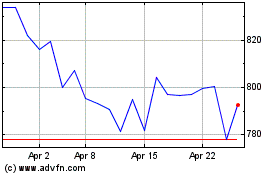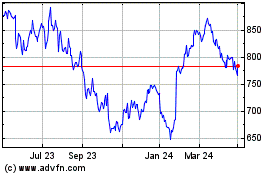Louis Vuitton, Dior Power LVMH's Sales
January 26 2021 - 4:18PM
Dow Jones News
By Matthew Dalton
PARIS -- LVMH Moët Hennessy Louis Vuitton SE said surging
revenue at its biggest fashion brands, Louis Vuitton and Dior,
propped up the luxury-goods company's results during the fourth
quarter, offsetting other businesses such as Champagne that have
fizzled during the pandemic.
The Paris-based conglomerate on Tuesday said revenue in the
quarter fell 3% to EUR14.3 billion ($17.4 billion). Sales at its
fashion and leather-goods division -- where Louis Vuitton and Dior
account for most of the revenue -- rose 18%. Revenue for all of
2020 fell 17% to EUR44.7 billion. Net profit for the entire year
was down 34% at EUR4.7 billion.
The results show how some of the marquee brands of luxury
fashion have gained market share during the pandemic. Louis
Vuitton, the world's top-selling luxury brand, Dior and Hermès have
posted strong sales growth since boutiques were allowed to reopen
after lockdowns in March and April. Smaller brands -- both inside
and outside LVMH -- have lagged behind.
Drawn by the performance of Dior and Louis Vuitton, investors
have sent LVMH's shares to near record highs, brushing aside
concerns about the future of the luxury business during and after
the pandemic. The company's market capitalization is now EUR260
billion, solidifying the place of Bernard Arnault, LVMH's chief
executive and controlling shareholder, among the ranks of the
world's wealthiest people.
Jean Jacques Guiony, LVMH's chief financial officer, said Louis
Vuitton and Dior had a strong pipeline of new products that they
continued to roll out despite the lockdowns. The brands also
maintained fashion shows in reduced formats and continued
digital-marketing efforts when others were forced to pull back
drastically. Dior, for example, held a closed-door fashion show for
its cruise collection in Lecce, Italy, in July, while rival brands
pushed the unveiling of new collections until later in the
year.
"We did it when nobody else was talking," Mr. Guiony said. "It
was really Dior and Vuitton taking the bulk of the customers'
attention."
Mr. Guiony said that Fendi and Celine -- two of LVMH's midsize
fashion brands -- also gathered momentum toward the end of the
year. Marc Jacobs managed to turn a profit in 2020 for the first
time in years, Mr. Guiony said, though that came after a wave of
layoffs at the American brand.
LVMH's performance also benefited from strong consumption of
Hennessy, the world's top-selling cognac brand. Sales in the U.S.
surged, LVMH said, bolstered by large government stimulus payments
to consumers. Global cognac volumes were down only 4% for the year
and rebounded in the second half, the company said.
That helped offset the poor performance of LVMH's Champagne
division, which includes brands such as Veuve Clicquot and Dom
Pérignon. With weddings and birthday parties canceled because of
social-distancing rules, consumers had little reason to sip a glass
of bubbly, pushing down Champagne sales by 19% for the year.
LVMH just completed its purchase of the American jeweler Tiffany
& Co. at the start of this year, after the pandemic nearly
canceled the $15.8 billion deal. Mr. Arnault plugged the plug on
the merger in September before deciding to see it through after
Tiffany agreed to a small discount.
The acquisition could be riding a tailwind: Jewelry sales in the
final months of last year were one of the bright spots in the
global luxury business, Mr. Guiony said.
Write to Matthew Dalton at Matthew.Dalton@wsj.com
(END) Dow Jones Newswires
January 26, 2021 16:03 ET (21:03 GMT)
Copyright (c) 2021 Dow Jones & Company, Inc.
Lvmh Moet Hennessy Louis... (EU:MC)
Historical Stock Chart
From Mar 2024 to Apr 2024

Lvmh Moet Hennessy Louis... (EU:MC)
Historical Stock Chart
From Apr 2023 to Apr 2024
